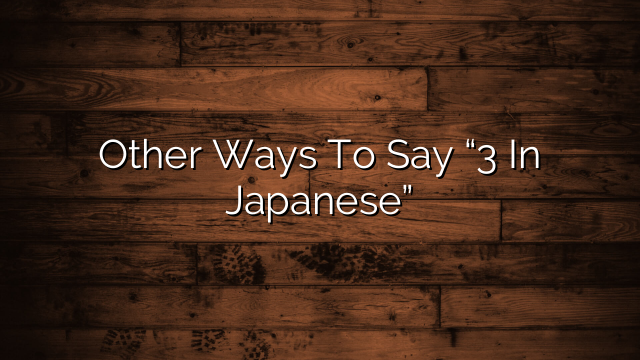In the rich tapestry of Japanese language and culture, the number ‘3’ holds a special place. It is not merely a numerical value but carries deep symbolism and significance. To truly appreciate the nuances of this seemingly simple digit, one must explore beyond its traditional representation in Japanese vocabulary.
This article delves into the various ways ‘3’ is expressed in different contexts, ranging from slang to alternative numerical expressions. Furthermore, it explores regional dialects that offer unique perspectives on this number. By examining these linguistic variations, we gain insight into how ‘3’ can be understood and interpreted across Japan.
Additionally, this article uncovers intriguing fun facts about the role of ‘3’ in Japanese culture. From superstitions to historical references, understanding these aspects provides a deeper appreciation for the cultural significance attached to this number.
Embark on this journey with us as we unravel the diverse ways in which ‘3’ is conveyed in Japanese language and discover its profound impact on both linguistics and culture.
Key Takeaways
- ‘3’ is expressed in various ways in different contexts and regional dialects in Japan.
- The traditional Japanese word for ‘3’ is represented by the kanji character 三 and pronounced as ‘san’.
- Regional variations of the word for ‘3’ exist, with some dialects pronouncing it as ‘mi’.
- Alternative numerical expressions for ‘3’ can be found in Japanese slang, but in formal settings, it is referred to as ‘san’.
The Traditional Japanese Word for ‘3’
The traditional Japanese word for ‘3’ is represented by the kanji character 三 and pronounced as ‘san.’
This word has regional variations, with some dialects pronouncing it as ‘mi’.
The kanji character itself evolved from the ancient Chinese pictograph for ‘three’, which depicted three horizontal lines.
Its historical significance lies in its usage not only in counting but also in various cultural aspects of Japan.
For example, in Shintoism, there are three sacred treasures called the Imperial Regalia of Japan: a mirror, a sword, and a jewel.
Additionally, the number three is often associated with harmony and balance in Japanese culture.
It is commonly seen in traditional art forms like haiku poetry, where poems typically consist of three lines.
These regional variations and cultural associations contribute to the rich linguistic and cultural heritage associated with the word for ‘3’ in Japanese.
Expressing ‘3’ in Japanese Slang
Expressing the numerical value of three in Japanese slang can be approached through various unconventional linguistic expressions that add a touch of humor and playfulness to the language. To engage the audience, here are three common slang phrases using the number ‘3’:
-
San-biki no kuma: This phrase literally translates to ‘three bears.’ It is used to describe someone who eats excessively or has a big appetite.
-
Mitsuboshi: Meaning ‘three stars,’ this term refers to someone who is talented, skilled, or successful in their field.
-
Sanku surfer: This phrase combines ‘san’ (three) and ‘thank you’ in English. It is often used humorously to express gratitude.
These slang phrases not only provide alternative ways of saying ‘3’ but also showcase the creativity and vibrancy of Japanese language usage in informal settings.
Alternative Numerical Expressions for ‘3’
Alternative numerical expressions for ‘3’ can be found in Japanese slang, adding a playful and humorous touch to the language. However, when it comes to expressing numbers in Japanese business settings, it is important to use standard numerical terms.
In these formal contexts, the number ‘3’ is simply referred to as ‘san.’ This straightforward approach ensures clear communication and avoids any potential confusion or misunderstandings.
On the other hand, in informal settings or everyday conversations, there are unique cultural references to the number ‘3’ that can be used. For example, people might use the phrase ‘mitsu’ which means three but also carries connotations of unity and harmony due to its association with the famous Japanese saying ‘Mitsu no kokoro,’ meaning three hearts beating as one. This expression highlights Japan’s emphasis on teamwork and cooperation.
Regional Dialects and ‘3’
Regional dialects in Japan have distinct variations in how the number ‘3’ is pronounced and understood, reflecting the linguistic diversity within the country. Regional variations of counting in Japanese can be observed in different dialects across Japan.
For instance, in the Kansai region, including cities like Osaka and Kyoto, the number ‘3’ is often pronounced as ‘mi’ instead of the standard ‘san’. Similarly, in parts of Tohoku and Hokkaido regions, it may be pronounced as ‘mii’ or ‘muu’. These regional differences not only highlight the linguistic diversity but also hold cultural significance.
In some regions, such as Okinawa, there are traditional folk songs that use unique pronunciations for ‘3’, showcasing its importance in local customs and traditions. Understanding these regional variations adds depth to one’s knowledge of Japanese language and culture.
Fun Facts about the Number ‘3’ in Japanese Culture
An intriguing aspect of the number ‘3’ in Japanese culture is its association with good luck and prosperity. Symbolism of the number ‘3’ can be found in various aspects of Japanese mythology. For example, the three-legged crow known as Yatagarasu is considered a divine messenger and symbolizes guidance and protection.
In addition, there are many triads or groups of three deities in Japanese mythology, such as the Three Treasures (mirror, jewel, sword), which represent purity, wisdom, and valor.
The significance of the number ‘3’ extends beyond mythology to Japanese art and architecture. In traditional paintings and prints, artists often use a composition called ‘sanjo-kai’ or ‘three-fold view,’ where three separate scenes are depicted within one artwork. This technique creates a sense of depth and movement.
Furthermore, in architecture, the concept of ‘miyadaiku’ involves using three primary pillars to support structures like shrines and temples. This design not only provides stability but also reflects balance and harmony.
Overall, the symbolism associated with the number ‘3’ in Japanese culture highlights its importance as a symbol of good fortune and artistic expression.
Frequently Asked Questions
What is the etymology of the traditional Japanese word for ‘3’?
The etymology of the traditional Japanese word for ‘3’ can be traced back to ancient times, reflecting the cultural significance attached to this numerical value in Japanese society. Its origins shed light on the deep-rooted symbolism and meanings associated with the number three.
Are there any cultural or historical references associated with the number ‘3’ in Japanese culture?
The number ‘3’ holds cultural significance in Japanese traditions and has historical references. It is associated with concepts such as luck, harmony, and balance. Examples include the three sacred treasures and the three beauties of Japan.
Can you provide examples of alternative numerical expressions for ‘3’ used in specific contexts, such as sports or gambling?
The number ‘3’ plays a significant role in Japanese literature and poetry, symbolizing completeness and balance. In traditional art forms like Ikebana and tea ceremonies, the number ‘3’ represents harmony among the three elements of heaven, earth, and humanity.
How does the slang expression for ‘3’ differ in different regions of Japan?
Regional variations in slang expressions for ‘3’ in Japan are influenced by modern pop culture. These variations differ across different regions, with each region having its unique way of expressing ‘3’, reflecting the cultural diversity and local influences.
Are there any superstitions or beliefs related to the number ‘3’ in Japanese culture?
Superstitions related to the number ‘3’ in Japanese culture include the belief that bad luck comes in threes. The significance of the number ‘3’ in Japanese folklore and mythology is seen in the Three Treasures, three important symbols representing power and authority.
Conclusion
In conclusion, there are various ways to express the number ‘3’ in Japanese depending on the context and regional dialects.
The traditional word for ‘3’ is ‘san,’ but slang expressions like ‘mittsu’ and alternative numerical expressions such as ‘zanmai’ or ‘mitsuji’ also exist.
It is interesting to note that the number ‘3’ holds cultural significance in Japan, representing harmony and balance.
Despite potential objections regarding the complexity of Japanese numerical expressions, understanding these different ways of saying ‘3’ adds depth and richness to one’s knowledge of the language.



